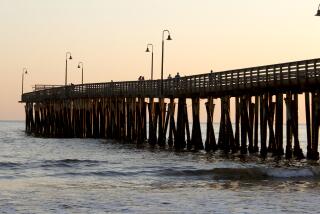Commentary : How Green Was This Valley? Future May Never Know
Based on the sounds we hear in the night, we guess our two morning papers are delivered around 5 a.m. Because of our coastal climate, we insist that they be bagged, lest the damp air render them mushy and unreadable. Coffee cup in hand, we retrieve them from the driveway by 6:30 or so.
When the temperature and humidity are just right, the moisture from the air collects on the outside of the plastic wrap and then consolidates into dozens of droplets.
With increasing frequency, we find them blackened by some unknown residue. The droplets must be carefully shaken off, so as not to stain one’s clothing and hands, and the bags must be removed before the newspapers can be brought indoors.
What is this black stuff? Is it the same as that in the thin, ebony film that deposits on the car when it sits outside for more than a few hours? Are we breathing it, too? Is the grime settling onto the tissues of our lungs? Is it being carried by an overnight zephyr from Los Angeles? Is it from the traffic on Interstate 5? Will the proposed San Marcos trash plant make it still worse? Is it something the Environmental Protection Agency is failing to detect?
We live in La Costa, which is really the southern half of Carlsbad. Sure, we have some rich folks and some snobs, but, for the most part, our community is a typical slice of middle-class America. Lots of us are quite ordinary and have the normal concerns about the environment. Not hysterical or irrational, but concerned.
One of our concerns is the loss of the valley we call Los Quiotes, which lies immediately to the north of our neighborhood. The valley is one of the last relatively unspoiled pastoral settings along the North Coast. The views from around the rim are stunning, and one cannot resist wondering if there might be a way to preserve this priceless scene forever.
The Los Quiotes Valley was acquired by movie and TV star Leo Carrillo in the 1930s, and he established a working rancho there as well as a residential compound that served as the site for many Hollywood-style parties and vacation getaways.
As the years and Carrillo’s life passed, hundreds of verdant acres--all but 10 acres that Carrillo donated to the city--were sold off to private buyers for future development.
Until now, however, there has been little or no development. The valley has remained much as it always was: serene, beautiful, refreshing. But the planners are signaling that a time of trauma is upon us, that the valley’s transformation into yet another suburban beehive draws near.
The city of Carlsbad, reacting to the demands of regional traffic circulation, is proposing to lace the valley with two major roadways, each designed to carry 50,000 cars a day. A north-south road will link an invigorated Vista and the infamous California 78 with Encinitas, the latter presently unprepared for the deluge of vehicles headed its way. An east-west highway will provide booming San Marcos with a straight shot to I-5 at Poinsettia Lane.
Where these arterials intersect will stand a new Scripps Hospital complex. It is a giant project; to the layman, the preliminary site plan looks overpowering. There is no way to really camouflage anything so large with so many buildings.
The hospital and its ancillary facilities will bring medical advances to legions of patients, plus more jobs, services, cars, trucks, buses and assorted emergency vehicles in monumental numbers. Pricey high- and low-density residential dwellings will follow as soon as the parkways create suitable access to the rolling valley countryside nearby.
The current property owners are absolutely within their rights to exploit their land investments. They will have to proceed within the dictates of the city’s much-acclaimed Growth Management Plan, thus assuring certain safeguards will be in place.
Leo Carrillo’s home place will be significantly augmented by new parks, trails, open space and scenic corridors contributed by developers. There is also talk of an arboretum that may arise amid the riparian habitat that marks a perennial stream bed. Today’s little 10-acre jewel will be expanded manyfold. It will always be a safe haven from the turmoil sure to surround it.
And there is the grave of Conquistador, Carrillo’s beloved palomino, who pastured here. A weathered cross stands tall and keeps its perpetual vigil from high atop a glorious promontory facing seaward over the Los Quiotes. This “hallowed ground” (Carrillo’s words) will fall victim to the road builders, but a thoughtful landowner has promised to move the grave site to a quiet plot near the hacienda.
There are, this may tell us, responsible developers out and about, and we expect them to perform at their shining best in the valley.
For the Carlsbad City Council and its staff, the disposition of the Los Quiotes is a tough call--one that will impact upon the health, safety, prosperity and environment of many generations to come. From personal experience, we know the city to be guided by sincere and dedicated professionals who are not easy marks for opportunists.
Nevertheless, we mourn the certain loss of so much of this lovely green valley.
The price of progress seems inordinately high. The benefits, economic and social, weigh heavily against the losses, environmental and philosophical. What will all that extra traffic and other activity mean when we pick up our newspapers from the driveway each morning? Will the grime be denser, blacker, stickier, uglier, more worrisome? Are there simply no practical alternatives? Apparently not.
More to Read
Sign up for Essential California
The most important California stories and recommendations in your inbox every morning.
You may occasionally receive promotional content from the Los Angeles Times.










